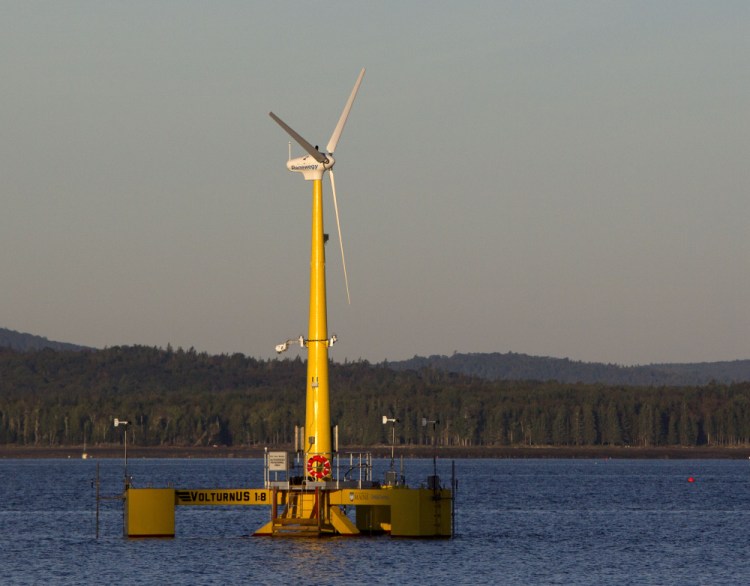A French defense company that has been expanding in marine energy technology has become a partner in Maine Aqua Ventus, the University of Maine-led consortium working to develop a floating offshore wind farm.
DCNS Group has announced that it will help develop the project, which in May became one of three offshore wind proposals eligible for nearly $40 million in funding from the U.S. Department of Energy.
Maine Aqua Ventus wants to build a pilot, 12-megawatt floating offshore wind farm off Monhegan Island. The project is seen as a critical step toward creating large-scale wind farms in the Gulf of Maine that could bring a vast, new clean-energy resource to the Northeast.
Beyond the university’s Advanced Structures and Composite Center, the Maine Aqua Ventus partnership includes Pittsfield-based contractor Cianbro Corp. and Emera Inc., the Nova Scotian parent company of utilities serving northern and eastern Maine.
DCNS says it has annual revenues of $3.47 billion and had roughly 13,000 employees in 10 countries.
The company’s role in the partnership is still being defined, according to Maine Aqua Ventus. But its arrival is important because it brings a well-financed, global player with experience in ocean energy to the venture at a critical time.
DCNS is a large European military contractor that builds submarines and naval ships. It also owns OpenHydro, an Irish company developing tidal power turbines.
OpenHydro is working with Emera to test pilot tidal power generators in the Bay of Fundy. That relationship is how DCNS came to Maine Aqua Ventus. The Canadian project, called Cape Sharp Tidal, has been delayed over protests by fishermen, but remains active.
In France, OpenHydro last month deployed a second tidal turbine for testing off the coast of Brittany.
In an email Wednesday to the Portland Press Herald, Frederic Le Lidec, DCNS’s marine renewable energy director, said the company is working on three marine renewable technologies – tidal energy, ocean thermal energy conversion and offshore wind – and is offering its services in engineering, construction, installation, maintenance and project management.
“Our knowledge of complex systems and maritime technologies, as well as our expertise in managing complex programs, allow us to play a driving role in marine renewable energy projects,” Le Lidec said. “We are willing to develop partnerships in countries, like the U.S., with a great potential for the development of these new resources.”
DCNS representatives have visited Maine a dozen times over the past year and its engineers have scrutinized the Aqua Ventus platform design, according to Habib Dagher, executive director of the composite center and the project’s lead researcher.
“They’re very excited about what we’re doing,” he said.
While many offshore wind farms in Europe have been built with steel towers anchored in the seabed, Maine Aqua Ventus is trying to refine a floating platform for use in deeper waters, made of concrete to fight corrosion and reduce costs.
In 2013, it launched a one-eighth-scale prototype off Castine and tested it for 18 months, while sending power back to the mainland grid. Researchers now are working to design two, 6-megawatt full-scale platforms.
Cianbro is expected to construct and assemble the platforms. DCNS may use its expertise in global contract procurement and management, as well as what it has learned from developing ocean energy projects, according to Jake Ward, UMaine’s vice president for innovation and economic development.
“Getting a huge, international corporation is helpful,” he said, “because it gives confidence that our team can build it on time and under budget.”
Even with the federal funding, the project will still need to attract a total of $150 million or so to be built, Ward said. He said that DCNS isn’t an equity partner in the project, but does have the potential to become one, if it chooses.
Send questions/comments to the editors.




Comments are no longer available on this story